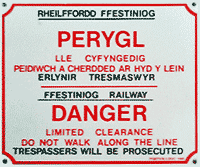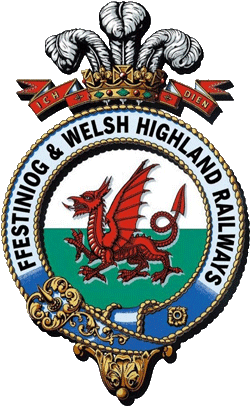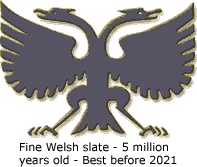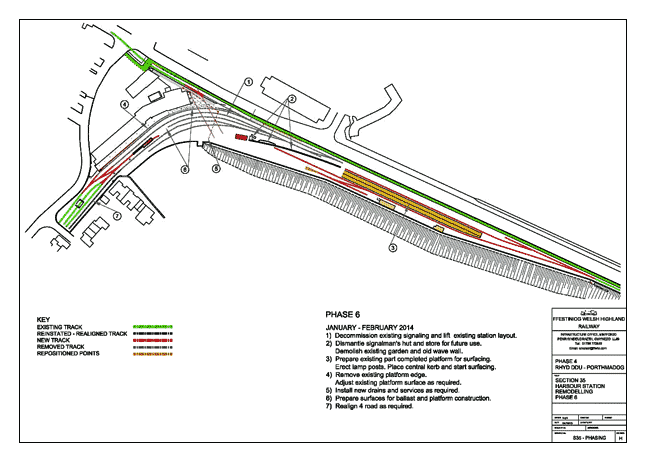Ffestiniog Railway & Welsh Highland Railways
Harbour Station Porthmadog
Gwynedd Wales United Kingdom
N52.923954 W4.126890
 (Porthmadog Station)
(Porthmadog Station)Well, they've done it! Ffestiniog and Welsh Highland Railway track now connects Caernarfon to Porthmadog to Blaenau Ffestiniog. The tramway track crossing the Britannia road bridge in Porthmadog from Ffestiniog Railway's Harbour Station, and the final link between the two railways, is now complete and functional. From Caernarfon through Porthmadog to Blaenau Ffestiniog the two railways are 38 and a half miles in total length. In 2014 major track improvements opened at Porthmadog Station enabling cross-platform interchange between the two railways.
The Ffestiniog narrow gauge railway (1 foot 11 1/2 inches) was constructed to transport wagons of slate downhill by gravity from the slate mines at Blaenau Ffestiniog to Porthmadog where it will be stacked on the jetty before being loaded onto sailing ships for world-wide delivery. The empty slate wagons return journey uphill was originally provided by horses hauling them back to Blaenau Ffestiniog.
In 1863 steam locomotives commenced hauling trains with the arrival of two of four George England & Company engines named "Princess" and "Mountaineer". Engines "Prince" and "Palmerston" arrived the following year. Primitive open carriages offering cheap transportation to the quarrymen were used. Later on, additional locomotives from the England Company arrived on the Ffestiniog in the form of Little Giant and Welsh Pony.
As the years passed traffic on the line increased until the capacity of the line approached its limit. The solution to this problem was the introduction of more powerful steam locomotives capable of negotiating the Ffestiniog's tight curves. Robert Double Fairlie, with his patented 0-4-0 + 0-4-0, "push me-pull you" looking articulated design provided the answer.

The first engine, known as Little Wonder, more than doubled the haulage capacity on the line. The Fairlies incorporation is but one of many things making the Ffestiniog Railway unique. As the years progressed the Ffestiniog improved on Fairlie's design building several more at its own Boston Lodge workshops across the estuary from Porthmadog.
If we do the math, then steam locomotives have operated on the Ffestiniog for 158 years, with the exception of the 1946 closure lasting until 1956, when steam service by Double Fairlie Livingston Thompson returned.
Slate is no longer the company's main source of revenue. Passenger fares on this intrepid line now contribute to company coffers. Support in the form of cash, and a labour of love by the Ffestiniog Railway Society, keeps the line alive. The railway would not be where it is today without the work carried out by volunteers. The number of riders continues to increase over the years providing much needed revenue for operations and has even provided for expansion of the Ffestiniog which is the now also the story of the Welsh Highland Railway.
With the completion of the Welsh Highland route from Porthmadog to Caernarfon a major renovation of the trackage at Porthmadog Station became the focus of the Ffestiniog. This entailed the widening of the Cob near Porthmadog station which commenced in 2012. The first phase of the plan involved delivery of some 25,000 tonnes of rock from nearby Minffordd Quarry. This enabled the western 260 metres of the 200-year-old Cob embankment to be widened for a new platform and to completely rework the station layout. Over the last weekend of January 2013 the North Wales Black Hand Gang continued work started by the Right-of-Way Gang installing new turnouts and rail on the Cob in connection with the Porthmadog Harbour Station redevelopment.Ballast was dropped, rail levelled and packed for both the Welsh Highland and Ffestiniog Platforms. By March of 2014 the renovations to the station, tracks, and signalling was compete so it was time to take a well-earned break and relax.

Learn more about James Spooner II in this Wikipedia article.
in this Wikipedia article.
Prince 0-4-0ST+T George England & Co. 1863.
Mountaineer I 0-4-0T+T George England & Co. 1863 dismantled 1879.
Palmerston 0-4-0ST+T George England & Co. 1864.
Little Giant 0-4-0ST+T George England & Co. 1867 dismantled 1929.
Welsh Pony 0-4-0ST+T George England & Co. 1867.
James Spooner I 0-4-4-0T Avonside Engine Co. 1872 dismantled 1929.
Merddin Emrys 0-4-4-0T Boston Lodge Works 1879.
Livingston Thompson 0-4-4-0T Boston Lodge Works 1886 named Taliesin II 1932-1961, Earl Of Merioneth I 1961-1971, Livingston Thompson at National Railway Museum.
Earl of Merioneth II 0-4-4-0T Boston Lodge Works 1979 replica.
David Lloyd George 0-4-4-0T Boston Lodge Works 1992.
James Spooner II 0-4-4-0T Boston Lodge Works 2021 estimated completion.
Taliesin III 0-4-4T Boston Lodge Works 1999 replica.
Moel Tryfan 0-6-4T Vulcan Foundry 1875 scrapped 1954.
Lilla 0-4-0ST Hunslet 1891 ex-Cilgwyn Quarry, Penrhyn Quarry, Bernard Latham, private consortium owned.
Linda 2-4-0ST+T Hunslet 1893 ex-Penrhyn Quarry.
Blanche 2-4-0ST+T Hunslet 1893 ex-Penrhyn Quarry.
Britomart 0-4-0ST Hunslet 1899 ex-Pen-yr-orsedd Quarry private consortium owned.
Mountaineer II 2-6-2T 1916 ALCO.
The Peckett 0-6-0ST Peckett & Sons 1944 to be named Volunteer sold 1987.
Monarch 0-4-4-0T Bagnall 1953 ex-Bowaters Paper Mill sold to Welshpool & Llanfair Light Railway.
Leary 0-4-0T FR Volunteer Group 2010 vertical boiler replica sold 2017.
Lyd 2-6-2T Boston Lodge Works 2010 Lynton & Barnstaple replica.
Conway Castle 4wDM F.C. Hibberd & Co. 1958 ex-RNAD Ernesettle.
Vale of Ffestiniog B-B CH Funkey & 1967 Co. ex-Consolidated Diamond Mines Namibia.
Criccieth Castle 0-6-0DH Boston Lodge Works 1995 from Baguley-Drewry parts.




